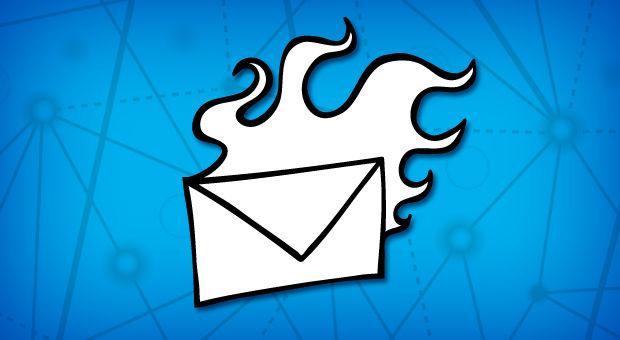With each new social network hitting the limelight, social media becomes a sexier force on the web. Email, by contrast, remains a largely unchanged technology since Ray Tomlinson sent the first email in 1971. Yet email still remains a highly profitable marketing channel. Here’s the reason why.
This is the first in a series of blog posts aimed at raising awareness of email marketing, its advantages, and its best practices — from designing your first eblast to deploying your newsletter to millions of customer inboxes, and beyond.
Why Email?
Facebook. Twitter. Pinterest. LinkedIn. With each new social network hitting the limelight, social media becomes a sexier force on the web. Email, by contrast, remains a largely unchanged technology since Ray Tomlinson sent the first email in 1971.
Over the decades we got carbon copy recipients, file attachments, and HTML-based emails, but that was it. No “like” buttons, status updates, or share functionality. Just some text, images, links, and a subject line.
That being said, email is a marketing channel your business can’t afford to do without.
Why? First, it’s profitable. As Felicity Evans of Smashing Magazine points out, email still has a very high ROI — an estimated $44 for each $1 spent in 2011.
Evans also reminds us that more Americans have been introduced to email than social networks. It’s simply been around a lot longer. Finally, the Smashing article makes the point that email is a unique identifier. In other words, most people have a couple addresses to their name, but are members of many different social networks.
Additionally, your email campaigns can help leverage a stronger social media presence and vice versa. “Share” buttons at the top of your enewsletter can raise visits to your company’s Twitter feed. Newsletter signup callouts on your Facebook page can bring in new subscribers for your eblasts and special offers.
Assuming you’re sold and you want your first email campaign out the door by the end of the week, where do you start? The best place to begin is logistics.
What system is the most efficient for communicating with your customers? What kind of system even sends out thousands, even millions of emails at once? The answer lies in something called an email service provider (ESP).
Finding the Right ESP
The Interactive Advertising Bureau defines an email service provider as, “a business or organization that provides the Email campaign delivery technology. ESPs may also provide services for marketing, advertising and general communication purposes.”
Deciding which ESP to use can be a daunting task. There are many ESPs out there. They vary in size, functionality, and features. Do you go with one of the big names, like ExactTarget, Constant Contact, Lyris, or Experian CheetahMail? Or maybe one of the numerous smaller ones?
It depends on what you need. If you’re a big company that already has a large email list, one of the larger ESPs might be right for you. The costs may be higher, but you’ll get additional perks. Some ESPs offer helpful features like image hosting, round-the-clock tech support, and marketing data on your customers’ viewing habits.
In terms of the larger ESPs, I would recommend ExactTarget. We use ExactTarget in campaign deployments for many of our clients. In addition to the analytics and great technical support offerings I mentioned above, they offer email automation (sending entire chains of emails with the click of a button), triggered sending (automatically sending an email when an end-user performs an action on your website), and more.
On the other hand, if you don’t need all these things, you’re operating on a smaller budget, and you only have a few hundred or thousand subscribers, a smaller ESP may work better for you.
Analytics
Detailed analytics isn’t just for your website and Facebook page. There are a variety of ways to get large amounts of data on how your subscribers will react to your email. As mentioned before, many of the larger ESPs will offer an email-tracking package right out of the box. These will usually give basic statistics. Things like how many subscribers opened your email, clicked a link, unsubscribed from your list, or hit the “Spam” button.
ESPs will also offer statistics on “bounces,” or emails that fail to reach a recipient’s email address because they were undeliverable for whatever reason. Bounce reporting is a very powerful tool as it can sometimes help you diagnose larger issues. If a lot of your subscribers use the same Internet service provider (ISP) and a lot of them suddenly bounce, it’s usually the canary in the coal mine indicating that ISP has blocked your campaigns. In a later blog article, I will detail what to do if this happens.
There are also a lot of free or low-cost analytics vendors out there that can help you get even more information on your subscribers’ habits. Google Analytics shows how visitors arriving at your homepage via your email’s links travel through your whole site. It even has conversion tracking, offering a great chance to see what percentage of sales are due to your email marketing channels.
Litmus, another helpful analytics vendor, tracks what programs and devices your users check their emails with. Do most of your customers view emails on an iPhone, or their office desktop? Do they use Microsoft Outlook, or Gmail? Litmus also gives information on how effective your campaign is in engaging your subscribers. It gives such helpful metrics as the average time your subscribers have your email open for. Are they scanning? Are they reading your every word?
CAN-SPAM Compliance
One pitfall to avoid if you’re just starting out in email marketing is CAN-SPAM. Signed into law in 2003, the CAN-SPAM Act makes it illegal to send unsolicited email, or spam. What this means is that you cannot market your services or products over email unless the recipient has opted in to receive your promotions or newsletters. This concept is also known as permission marketing.
But it’s not enough to let your users opt in. They also have to be able to opt out. Unless you are sending a transactional email (the email equivalent of a receipt), you must place a link somewhere in your communications to a page where your users can unsubscribe. It’s not just the law, but it’s also a great way to avoid customer service nightmares. Think about it. We’ve all been there. We signed up for a service on the Internet and absently left the checkbox clicked for “Please send me your free monthly newsletters and special offers!” Before you know it, you’re getting 10 emails a week that you really don’t care to read. The unsubscribe link at the bottom of that email gives subscribers who got on your list by mistake an easy way out.
Another thing that CAN-SPAM requires is an address. All your marketing emails, transactional or promotional, must contain your company’s physical mailing address. This also helps the consumer in that it shows you’re a real company in a real location somewhere in the world.
If that’s a lot to keep track of, don’t worry. Many larger ESPs have features built in that allow to automatically place your mailing address and unsubscribe link in all your emails. Some even have safeguards that prevent your email from going out unless it is fully CAN-SPAM compliant.
Next Time — Building Your List
It’s easy to see how difficult it is to send emails only to subscribers who opt in, especially if your email campaign list numbers 0 subscribers. The temptation might creep up to go out and buy a subscriber list. Don’t. None of these users have opted in. Not only would sending to them be illegal, but it will also earn you a bad reputation. Users who hit the “Spam” button on a given email address frequently enough will get blacklisted by ISPs. This means all emails you send will bounce.
Besides, there are more ethical, legal, and organic ways to build a subscriber list. In my next post, I will go over the basics of list building and list health. You will be surprised at how easy it is to generate opt ins with some of the resources you already have. Don’t miss it!





